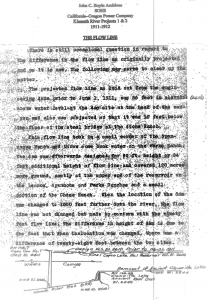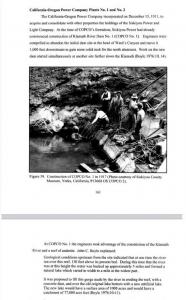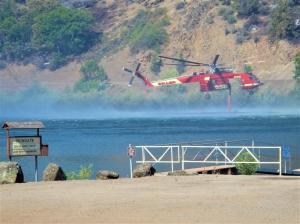
When dam builder / engineer J.C. Boyle arrived at Ward Canyon on the Klamath River, the present-day site of Copco 1 dam, he saw a series of natural lava flow dams, one of which was 31-feet-tall and holding back a lake called Clammitee Lake

Dam builder / engineer J.C. Boyle's narrative and drawing of the lava flows and natural 31-foot-tall dam holding back a lake in 1913 at the present site of Copco 1 dam

Department of Interior document citing narrative and photo of the lava flows and natural 31-foot-tall dam holding back a lake in 1913
1913 drawings by J.C. Boyle reveal natural lava dam and lake - Salmon migration past this barrier unlikely
The key reasoning being promoted for the removal of the Klamath River dams by minority stakeholders is, to restore a theoretical Salmon migration to the upper Klamath River basin.
Compelling new evidence argues such a migration was not possible beyond Ward Canyon.
Indisputable facts have just come to light suggest there was a migration. But, salmon did not get past the series of natural high dams that were formed millions of years ago. These lava flows, formed dams across the Klamath River at Ward Canyon, which impeded any fish migration. This is the site of the present-day Copco 1 dam.
One of these lava dams, a 31-foot-tall natural dam, was in place and holding-back a lake in 1911 when dam engineer J.C. Boyle arrived on-scene to begin the process of building the Copco 1 dam.
As an engineer building dams, accuracy was part J.C. Boyle’s trade. In a series of two drawings made by J.C. Boyle in 1913, accompanied by a narrative description, that skilled engineer depicted a natural dam that was 31-feet-tall holding back a natural lake named ‘Clammitte Lake’. (See Images).
An adult salmon has the capacity to jump a maximum of about 12-feet. So, breaching a 31-foot-tall dam was impossible. And the 31-foot-tall dam was standing in-place until Copco 1 dam was completed in 1918, which produced a larger artificial lake that covered the natural lake and its smaller dam.
Conclusion:
Salmon migration on the Klamath River was prevented beyond Ward Canyon by natural forces that have been in-play for millions of years, and right up until the time Copco 1 dam was built.
Minority Stakeholder Conjecture Number Two: The dams serve no real purpose.
Is the beneficial use of 45-billion gallons of fresh water during a record drought and water crises an important purpose? Congress thought so when they passed the Klamath River Basin Compact Act.
It’s shocking that in the middle of the current record period of drought and ‘water crisis’, the governors of Oregon (Kate Brown) and California (Gavin Newsome) have arguably been duped into collaborating with Berkshire Hathaway’s profitable Pacific Corp, a shell-corporation called Klamath Basin Renewal Corporation (KRRC) and a relatively few minority stakeholders to circumvent established law, a Congressional Act, the Klamath River Basin Compact. And through their proposed dam removal process, wrongfully remove 4-dams providing water storage during intensifying record drought.
The proposed Klamath River dam removal process would deprive a super-majority of Americans of their ‘beneficial use’ and rights to the 45-billion gallons of water contained in Copco and Iron Gate Lakes for domestic and agricultural uses, recreation, wildlife, firefighting and more.
“In addition to circumventing the Act in an attempt to remove the dams without Congressional approval, this dam removal project arguably flies in the face of the Public Trust Doctrine (‘PTD’), which requires the ‘highest and best use’ of the public’s natural resources in the beneficial interest of a majority of Americans. Instead, this project seeks to deprive the overall majority of American voters of their democratic process in to favor the illogical demands of a small minority who are supported merely by money and power”; said naturalist William E. Simpson II
Three of the four Klamath River dams proposed for removal are in Siskiyou County, CA, where a referendum proved that 78.84% of voters were against the Klamath dam removal project.
In Klamath County Oregon, where one of the Klamath River dams is located, voters considered whether the four hydroelectric dams on the Klamath River should be removed. That vote proved 72% of voters opposed to the removal.
Endangered and threatened species reliant upon critical habitat provided by Copco and Iron Gate Lakes.
The lakes and shoreline-based ecosystems of Copco and Iron Gate lakes also provide critical habitat for both threatened and endangered species of flora and fauna. The eleven-miles of the Klamath River Canyon where these lakes are located contains an amazing diversity of wildlife, including 89 species of birds, dozens of reptiles and amphibians, several species of fish and 71 species of plants including trees, grasses and forbs. Some species of this localized flora and fauna are threatened or endangered.
These facts have been understated and obfuscated by dam-removal proponents.
The economics of financial doom and taxpayer liability:
In a March 4, 2021, a Capitol Press article by George Plaven, reported that a ‘maximum price’ for the cost of removing the Klamath River Dams has been set at $446-million dollars. That cost was promoted as being within the project’s budget by the shell corporation Klamath Basin Renewal Corporation (‘KRRC’).
KRRC was formed in 2016, and has no empirical experience in the operations or demolition of hydroelectric dams. KRRC was formed with the myopic mission to remove 4-dams; J.C. Boyle, Copco 1, Copco 2 and Iron Gate Dams.
KRRC’s dam removal plan, which is unprecedented in scope and risk, has many moving parts, each of which are interdependent upon successful execution of major assignments by other contractors. Like dominoes, if one thing goes wrong, the succession of problems and costs will surely skyrocket.
Mr. Plaven’s article stated:
“The $446 million price tag is considered the “guaranteed maximum price,” including $199 million for Kiewit Infrastructure West, the project’s main contractor, and $78 million for Resource Environmental Solutions, which will head the environmental cleanup and restoration effort”.
“Funding for dam removal comes primarily from PacifiCorp ratepayers, who have contributed $200 million, and up to $250 million from California Proposition 1, a $7.5 billion statewide water bond that passed in 2014.”
Most of the cost projections for the Klamath River dam removal project budget were determined prior to and without a complete understanding of the recent major escalation in costs for materials, labor, fuel, logistics and the other cost-related impacts of COVID on the economy and construction related projects.
KRRC’s dam removal plan doesn’t have fixed costs. But it does have a fixed budget.
And now, some of the first analyses of COVID economics are coming available and paint a dire picture for the presumed Klamath Dams removal budget being pitched by KRRC at $446-million.
Moreover, the budget projections are based upon the best-case outcome of a massive and first-time project that is laden with numerous unprecedented risks of a magnitude never seen or engaged before.
Astoundingly, planners have allocated a mere 10% ($45-million) contingency fund, which would be collected from California and Oregon taxpayers should things go wrong.
Clearly, this is not a simple job like building a home, where a 10% contingency fund would be more in line with reality based upon what is seen in small contract over-run.
Given the magnitude of the risks of this unique dam removal project, $45-million doesn’t even begin to cover just the budget adjustments needed for pre-COVID inflation.
Recent astronomical cost increases (‘COVID economics’) are not built into KRRC’s projected budget!
It is not unreasonable to consider that in a ‘first-time’ project that is immense in scope, any number of things can, and do go terribly wrong. KRRC’s dam removal project could lead to an unprecedented environmental and ecological disaster that by some accounts could take a decade or more for the Klamath River to recover, if ever. Homeowners and property owners (about 300) around the lakes will suffer significant drops in property value if the lakes behind the dams are gone. In many cases domestic water wells will lose production or go dry, in which cases, property and homes without water are practically worthless.
Of course, anyone in business knows that if projected costs are based on a ‘best case’ outcome, and a mediocre, or worse yet, a bad outcome evolves, costs, damages and liabilities can escalate very quickly and steeply.
The Associated General Contractors of America has issued a report and graph-analyses showing the huge impacts that COVID economics (period April 2020 thru February 2021) has had on skyrocketing costs related to construction projects.
The Associated General Contractors of America study exemplifies the huge cost increases and long delays that occurred in the year since KRRC’s budget projections were estimated and later “guaranteed at $450-million”.
For the purpose of cost-impact analyses, the COVID economics study began in April 2020 thru February 2021. (https://www.agc.org/sites/default/files/AGC 2021 Inflation Alert - Ver1.1.pdf).
The Associated General Contractors of America report stated:
"The construction industry is currently experiencing an unprecedented mix of steeply rising materials prices, snarled supply chains, and staffing difficulties, combined with slumping demand that is keeping many contractors from passing on their added costs.
This combination threatens to push some firms out of business and add to the industry’s nearly double-digit unemployment rate. The situation calls for immediate action by federal trade officials to end tariffs and quotas that are adding to price increases and supply shortages.
Officials at all levels of government need to identify and remove or lessen any unnecessary or excessive impediments to the importation, domestic production, transport, and delivery of construction materials and products.
Project owners need to recognize how much conditions have changed for projects begun or awarded in the early days of the pandemic or before and to consider providing greater flexibility and cost-sharing. Contractors should become even more vigilant about changes in materials costs and expected delivery dates and should communicate the information promptly to current and prospective clients.
This report is intended to provide all parties with better understanding of the current situation, the impact on construction firms and projects, its likely course in the next several months, and possible steps to mitigate the damage.”
The Associated General Contractors of America report spells financial disaster for KRRC’s project. And the burden of that disaster will surely fall upon the shoulders of California and Oregon taxpayers.
History of smaller dam removal project cost over-runs - A red flag for a larger more complex dam removal project.
According to the Penninsula Daily News in Port Angeles Washington:
“The three-year Elwha River dams removal project will begin in 2012 and cost an estimated $308 million, plus or minus 15 percent, the National Park Service said.
The estimated cost of removing the Elwha and Glines Canyon dams from the Elwha River has increased from the $135 million price tag cited in its last comprehensive budget estimate in 2001.”
Another accounting of the ‘projected costs’ via Wiki, shows that the Elwha River dams removal project cost projections were escalating, even as projections were being made. This should be a big red-flag for the costs of the much larger and far more ambitious project and estimated budge of $450-million to remove four Klamath River dams:
“Removal of the Elwha Dam began in September 2011 and was finished in spring 2012, ahead of schedule. Removal of the second dam, the Glines Canyon Dam, was completed on August 26, 2014. The dam removal process was originally projected to last two and a half to three years. The estimated cost of removing both dams was $40 to $60 million. The total cost of the Elwha River restoration is approximately $351.4 million.” ~ Wiki
In the foregoing example, a smaller and simpler dam removal project compared to the four dams on the Klamath River, the costs were much more than estimated, and the project took longer than projected. And in the case of Elwha River dams, the potential for environmental, ecological and private property damages were far less.
Will Oregon and California Taxpayers be subjected to this boondoggle?
The economic hardship related to a more realistic $800-million+ price tag, coupled with increasing liabilities that the project would place on taxpayers of Oregon and California, combined with the devastation to the environment, habitat and loss of rare species of flora and fauna, along with real estate devaluation, demands that the Klamath Dam removal project be reevaluated top-to-bottom!
We must demand a halt to this reckless project while legislators in Oregon and California hold public hearings on the matter ASAP!
Richard Marshall
Siskiyou County Water Users Association
+1 530-468-4204
email us here
Visit us on social media:
Facebook
CAL-FIRE Battalion Chief Mike Alforque discusses critical importance that water from Iron Gate Lake played saving the Cascade Siskiyou National Monument
















